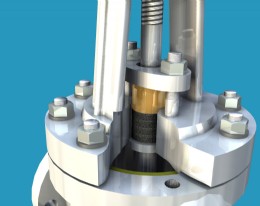Gaskets don’t leak
– bolted joint assemblies do!

On start-up the steam valve was completely leak free, and it has remained leak free ever since

James Walker carried out a detailed examination of elements including housing configuration, stem surface condition
Sealing success
A 24-inch valve at a nuclear power plant was rendered totally leak free for the first time in seven years, following the application of a technology driven approach to achieving joint integrity.
Engineers at the plant called in James Walker after attending a presentation on assuring joint integrity using RotaBolt® tension control systems. Their problem was a giant steam valve that had always leaked on start up.
Test pressure for the valve is 130bar, with start-up at 160bar under increasing temperature. Working pressure is 60bar at 260°C. In order to achieve a perfect seal, James Walker recommended the use of 20 off 3-inch OD by 580mm long RotaBolt 2 studs, and a complete redesign of the valve’s flange joint.
The new joint design incorporated a Metaflex® CW/IR spiral wound gasket, plus a silver plated C-ring and a modified housing arrangement. All design modifications were checked and approved for the plant operator by an external consultancy. The upgraded steam valve was then installed during the plant’s main shutdown.
On start-up the steam valve was completely leak free, and it has remained leak free ever since — thanks to a totally integrated approach to assuring bolt integrity.
Reducing Total Cost of Ownership
Bolted joint integrity is one of the cornerstones of the James Walker Total Cost of Ownership (TCO) Reduction Programme through which the company is helping its customers to reduce maintenance costs and improve plant safety and performance.
‘We are focusing our efforts on the critical joints and flanges related to valves,’ explains global marketing and business development manager – valves, John Bowers. ‘The vast majority of maintenance problems are created by incorrect installation, incorrect product specification or cost-cutting measures. Our service identifies the correct products and specifications that should be used and we will also often undertake training of engineering teams, providing fitting instructions and maintenance schedules where necessary to ensure the issue is resolved.
In other cases we may re-design or re-engineer a flange, housing or seal to eliminate the cause of the maintenance issue. We can offer this sort of service because we have both total control over the design and manufacture of our products and materials as well as dedicated design and applications engineering teams with an in-depth knowledge of the valve industry and applications we service.’
Valve management solutions
The same philosophy of establishing and curing the root cause of a problem rather than simply treating the symptoms or applying a patch, extends to our work with fugitive emissions from valves. Experience from the field and from comprehensive in-house testing as well as joint testing with external test houses and OEMshas provided an understanding of the critical elements - over and above the use of suitable quality components – that need to be put into place to optimise the emissions performance and reduce the cost of ownership of all valve types.
Looking at the root of each emissions problem includes detailed examination of elements including housing configuration, stem surface condition and material before specifying the ideal sealing product. Detailed fitting guides also play an important role in helping optimise valve performance – correct fitting of stem sealing product ensuring trouble-free valve operation with minimal fugitive emissions.
John Bowers concludes; ‘Through the testing programmes we use to develop our materials and products, we discovered that engineering practices in the field were often the limiting factors in the performance of products, so now, in order to extract the optimum performance from our products we are offering customers a comprehensive application and design engineering service that addresses these additional factors. The result of such a comprehensive, joined-up approach is unsurprisingly, improved plant performance in terms of emissions and safety through elimination of leakage plus reduced maintenance costs through a combination of extended product life and removal of the need for unscheduled maintenance between outages. Within the power industry this whole package of benefits adds up to the ultimate goal of increasing availability to generate.’
James Walker
Tel: 01900 823555
www.jameswalker.biz

| Telephone: | 01270 536000 |
| Email: | sales.uk@jameswalker.biz |
| Website: | www.jameswalker.biz |
| More information on the James Walker BVAA Member Directory Page |
Search related valve / actuator articles: James WalkerIssue 29Gaskets







-web.jpg)





